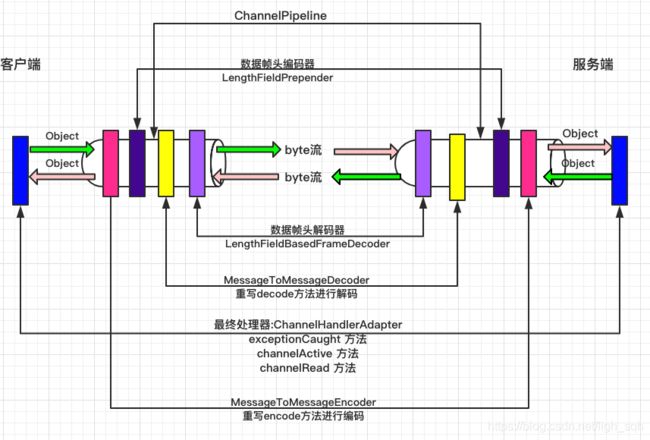网络编程之Netty实践(三)
一.介绍
Netty是由JBOSS提供的一个java开源框架。Netty提供异步的、事件驱动的网络应用程序框架和工具,用以快速开发高性能、高可靠性的网络服务器和客户端程序。也就是说,Netty 是一个基于NIO的客户、服务器端编程框架,使用Netty 可以确保你快速和简单的开发出一个网络应用,例如实现了某种协议的客户、服务端应用。Netty相当于简化和流线化了网络应用的编程开发过程,例如:基于TCP和UDP的socket服务开发。
“快速”和“简单”并不用产生维护性或性能上的问题。Netty 是一个吸收了多种协议(包括FTP、SMTP、HTTP等各种二进制文本协议)的实现经验,并经过相当精心设计的项目。最终,Netty 成功的找到了一种方式,在保证易于开发的同时还保证了其应用的性能,稳定性和伸缩性。
二.原理
设计原理图:
三.demo实战
1.客户端最终处理器
import io.netty.buffer.ByteBuf;
import io.netty.buffer.Unpooled;
import io.netty.channel.ChannelHandlerAdapter;
import io.netty.channel.ChannelHandlerContext;
import io.netty.util.CharsetUtil;
import java.util.Date;
/**
* 客户端最终处理器
*/
public class ClientChannelHandlerAdapter extends ChannelHandlerAdapter {
/**
* 捕获错误异常
* @param ctx
* @param cause
* @throws Exception
*/
@Override
public void exceptionCaught(ChannelHandlerContext ctx, Throwable cause) throws Exception {
System.err.println("错误: "+cause.getMessage());
}
/**
* 建立和服务器的连接后调用,一般在这里主动发送消息
* @param ctx
* @throws Exception
*/
@Override
public void channelActive(ChannelHandlerContext ctx) throws Exception {
//测试项服务端传递对象,服务端是肯定接收不到的
ctx.writeAndFlush(new Date());
}
/**
* 接受服务端响应
*
* @param ctx
* @param msg
* @throws Exception
*/
@Override
public void channelRead(ChannelHandlerContext ctx, Object msg) throws Exception {
/*ByteBuf buf = (ByteBuf) msg;
System.out.println("收到服务器发的消息:"+buf.toString(CharsetUtil.UTF_8));*/
//测试接受服务端传递过来的对象,肯定接收不到的
System.out.println("收到服务器的消息:"+msg);
}
}
2.服务端最终处理器
import io.netty.buffer.ByteBuf;
import io.netty.buffer.Unpooled;
import io.netty.channel.ChannelFuture;
import io.netty.channel.ChannelFutureListener;
import io.netty.channel.ChannelHandlerAdapter;
import io.netty.channel.ChannelHandlerContext;
import io.netty.util.CharsetUtil;
import java.util.Date;
/**
* 服务端最终处理器
*
*/
public class ServerChannelHandlerAdapter extends ChannelHandlerAdapter {
/**
* 捕获netty服务异常
*
* @param ctx
* @param cause
* @throws Exception
*/
@Override
public void exceptionCaught(ChannelHandlerContext ctx, Throwable cause) throws Exception {
System.err.println("错误: "+cause.getMessage());
}
/**
* 收/发消息
* @param ctx 负责发送消息
* @param msg 服务端收到消息
* @throws Exception
*/
@Override
public void channelRead(ChannelHandlerContext ctx, Object msg) throws Exception {
//测试传递原生对象,也就是收到msg,返回客户端msg,字符串的话是返回buffer
System.out.println(msg);
ChannelFuture channelFuture = ctx.writeAndFlush(msg);
//注册关闭listener监听器
channelFuture.addListener(ChannelFutureListener.CLOSE);
}
}
3.手写序列化工具类:
import java.io.ByteArrayInputStream;
import java.io.ByteArrayOutputStream;
import java.io.ObjectInputStream;
import java.io.ObjectOutputStream;
public class SerializationUtils {
/**
* 序列化
*
* @param obj
* @return
*/
public static byte[] serialize(Object obj) {
ByteArrayOutputStream baos = new ByteArrayOutputStream();
try{
ObjectOutputStream oos = new ObjectOutputStream(baos);
oos.writeObject(obj);
oos.flush();
oos.close();
}catch (Exception e){
e.printStackTrace();
}
return baos.toByteArray();
}
/**
* 反序列化
*
* @param bytes
* @return
*/
public static Object deserialize(byte[] bytes){
try{
ByteArrayInputStream bais = new ByteArrayInputStream(bytes);
ObjectInputStream ois = new ObjectInputStream(bais);
Object obj = ois.readObject();
ois.close();
return obj;
}catch (Exception e){
e.printStackTrace();
}
return null;
}
}
4.编码器:
import io.netty.buffer.ByteBuf;
import io.netty.buffer.Unpooled;
import io.netty.channel.ChannelHandlerContext;
import io.netty.handler.codec.MessageToMessageEncoder;
import java.util.List;
/**
* 编码器 对Obejct对象进行编码
*/
public class ObjectEncoder extends MessageToMessageEncoder5.解码器:
import io.netty.buffer.ByteBuf;
import io.netty.channel.ChannelHandlerContext;
import io.netty.handler.codec.MessageToMessageDecoder;
import java.util.List;
/**
* 解码器 对ByteBuf进行解码,转换成对象
*/
public class ObjectDecoder extends MessageToMessageDecoder {
@Override
protected void decode(ChannelHandlerContext channelHandlerContext, ByteBuf msg, List out) throws Exception {
System.out.println("解码...");
//将ByteBuf中的数据转换成字节数组
byte[] bytes = new byte[msg.readableBytes()];
msg.readBytes(bytes);
//进行解码,转换成对象,写进list集合中也就是帧中
Object obj = SerializationUtils.deserialize(bytes);
out.add(obj);
}
}
6.初始化客户端通信管道:
import io.netty.channel.ChannelInitializer;
import io.netty.channel.ChannelPipeline;
import io.netty.channel.socket.SocketChannel;
import io.netty.handler.codec.LengthFieldBasedFrameDecoder;
import io.netty.handler.codec.LengthFieldPrepender;
/**
* 初始化客户端通信管道
*/
public class ClientchannelInitializer extends ChannelInitializer {
@Override
protected void initChannel(SocketChannel socketChannel) throws Exception {
//获取管道
ChannelPipeline pipeline = socketChannel.pipeline();
//数据帧头解码器 最大帧长度2的16次方减一 偏移量 数据帧头长度 长度调整量 数据截取跳的长度
pipeline.addLast(new LengthFieldBasedFrameDecoder(65535,0,2,0,2));
//添加数据帧头编码器
pipeline.addLast(new LengthFieldPrepender(2));
//添加解码器
pipeline.addLast(new ObjectDecoder());
//添加编码器
pipeline.addLast(new ObjectEncoder());
//指定消息最终处理者
pipeline.addLast(new ClientChannelHandlerAdapter());
}
}
7.初始化服务端通信管道:
import io.netty.channel.ChannelInitializer;
import io.netty.channel.ChannelPipeline;
import io.netty.channel.socket.SocketChannel;
import io.netty.handler.codec.LengthFieldBasedFrameDecoder;
import io.netty.handler.codec.LengthFieldPrepender;
/**
*
* 初始化服务端通信管道
*
*/
public class ServerChannelInitializer extends ChannelInitializer {
@Override
protected void initChannel(SocketChannel socketChannel) throws Exception {
//获取管道
ChannelPipeline pipeline = socketChannel.pipeline();
//数据帧头解码器 最大帧长度2的16次方减一 偏移量 数据帧头长度 长度调整量 数据截取跳的长度
pipeline.addLast(new LengthFieldBasedFrameDecoder(65535,0,2,0,2));
//添加数据帧头编码器
pipeline.addLast(new LengthFieldPrepender(2));
//添加解码器
pipeline.addLast(new ObjectDecoder());
//添加编码器
pipeline.addLast(new ObjectEncoder());
//添加最终处理者
pipeline.addLast(new ServerChannelHandlerAdapter());
}
}
四.最终demo实践
1.客户端
import io.netty.bootstrap.Bootstrap;
import io.netty.channel.ChannelFuture;
import io.netty.channel.nio.NioEventLoopGroup;
import io.netty.channel.socket.nio.NioSocketChannel;
/**
* netty 客户端
*/
public class NettyClientDemo {
public static void main(String[] args) throws InterruptedException {
//1.创建客户端引导
Bootstrap bt = new Bootstrap();
//2.创建线程池 worker请求处理
NioEventLoopGroup worker = new NioEventLoopGroup();
//3.关联线程池
bt.group(worker);
//4.设置Nio客户端实现
bt.channel(NioSocketChannel.class);
//5.初始化通信管道 ----重点
bt.handler(new ClientchannelInitializer());
//6.连接服务端
ChannelFuture channelFuture = bt.connect("127.0.0.1",9999).sync();
//7.关闭与服务端之间的通信管道
channelFuture.channel().closeFuture().sync();
//8.释放线程资源
worker.shutdownGracefully();
}
}
2.服务端
import io.netty.bootstrap.ServerBootstrap;
import io.netty.channel.ChannelFuture;
import io.netty.channel.nio.NioEventLoopGroup;
import io.netty.channel.socket.nio.NioServerSocketChannel;
/**
* netty服务端
*/
public class NettyServerDemo {
public static void main(String[] args) throws InterruptedException {
//1.创建服务启动引导
ServerBootstrap sbt = new ServerBootstrap();
//2.创建线程池 boss负责请求转发 worker负责相应处理
NioEventLoopGroup boss = new NioEventLoopGroup();
NioEventLoopGroup worker = new NioEventLoopGroup();
//3.关联线程池
sbt.group(boss,worker);
//4.设置Nio服务端实现
sbt.channel(NioServerSocketChannel.class);
//5.初始化通讯管道 -----重点
sbt.childHandler(new ServerChannelInitializer());
//6.绑定端口启动netty服务
System.out.println("我在9999监听....");
ChannelFuture channelFuture = sbt.bind(9999).sync();
//7.关闭与客户端间的通讯管道
channelFuture.channel().closeFuture().sync();
//8.释放线程资源
boss.shutdownGracefully();
worker.shutdownGracefully();
}
}
五.总结
以上就完成了netty的设计原理以及demo实践过程,总的来说netty是非常好用的,尤其是在通过Netty手写RPC通信的时候,以后我会更新一篇手写RPC的文章,以上就完成了从BIO–>NIO–>Netty的研究和学习。
不仅要知其依然也要知其所以然 -----李国辉
